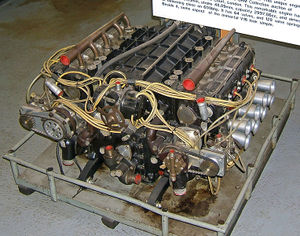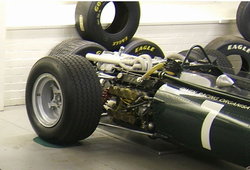Flat-H
An H engine (or H-block) is an engine configuration in which the cylinders are aligned so that if viewed from the front, they appear to be in a vertical or horizontal letter H.
An H engine can be viewed as two flat engines, one atop or beside the other. The "two engines" each have their own crankshaft, which are then geared together at one end for power-take-off. This leads to a worse power-to-weight ratio than simpler configurations with only one shaft. The only obvious advantage of the H configuration is to allow the building of reasonably short engines with more than 12 cylinders, their compact size being useful as aircraft engines where their small size allows for better aerodynamics - see Lycoming. The U engine is a similar concept, except that it uses two straight engines.
Examples
The H configuration is very uncommon. Known examples are:
Road vehicles
- The British Racing Motors (BRM) H-16 Formula One engine; this was a major failure. The engine was powerful, but the design was hampered not only by its low torque and a high center of gravity but also was heavy, unreliable and very complex, with gear-driven twin overhead cams for each of four cylinder heads, two gear-coupled crankshafts, and mechanical fuel injection. Jackie Stewart is believed to have said "This piece of metal is better used as a ship's anchor than as a power plant". Despite its poor reputation Jim Clark managed to win the 1966 US Grand Prix with a Lotus 43 powered by this engine. [1]
- The Brough Superior 1000cc Golden Dream motorcycle, first shown in 1938. This was an H-4 design but only a few units were produced in early 1939.
Aircraft engines
- The Lycoming H 2470 hyper engine, that did not go into production.
- Napier & Son
- Rolls-Royce Eagle H-24, 46.2 litres, 3,200 hp
- Fairey Aviation Fairey H-16 "Prince", 1,500 hp
Unlike the BRM, the Lycoming and the Eagle, the Sabre was eventually developed to be a successful engine.
Other uses of H term
Subaru produces water-cooled flat-4 and flat-6 "Horizontal" engines that are marketed as H-4 and H-6, despite the fact that their configuration has nothing to do with a real H engine.
| Piston engine configurations | |
|---|---|
| Straight | Single, 2, 3, 4, 5, 6, 8, 9, 10, 12, 14 |
| V | 2, 4, 5, 6, 8, 10, 12, 16, 20, 24 |
| Flat | 2, 4, 6, 8, 10, 12, 16, H |
| W | 8, 9, 12, 16, 18 |
| Other inline | H, VR, Opposed, U (Square), X |
| Other | Hemi, Radial, Rotary, Pistonless, Deltic, (Wankel) |

